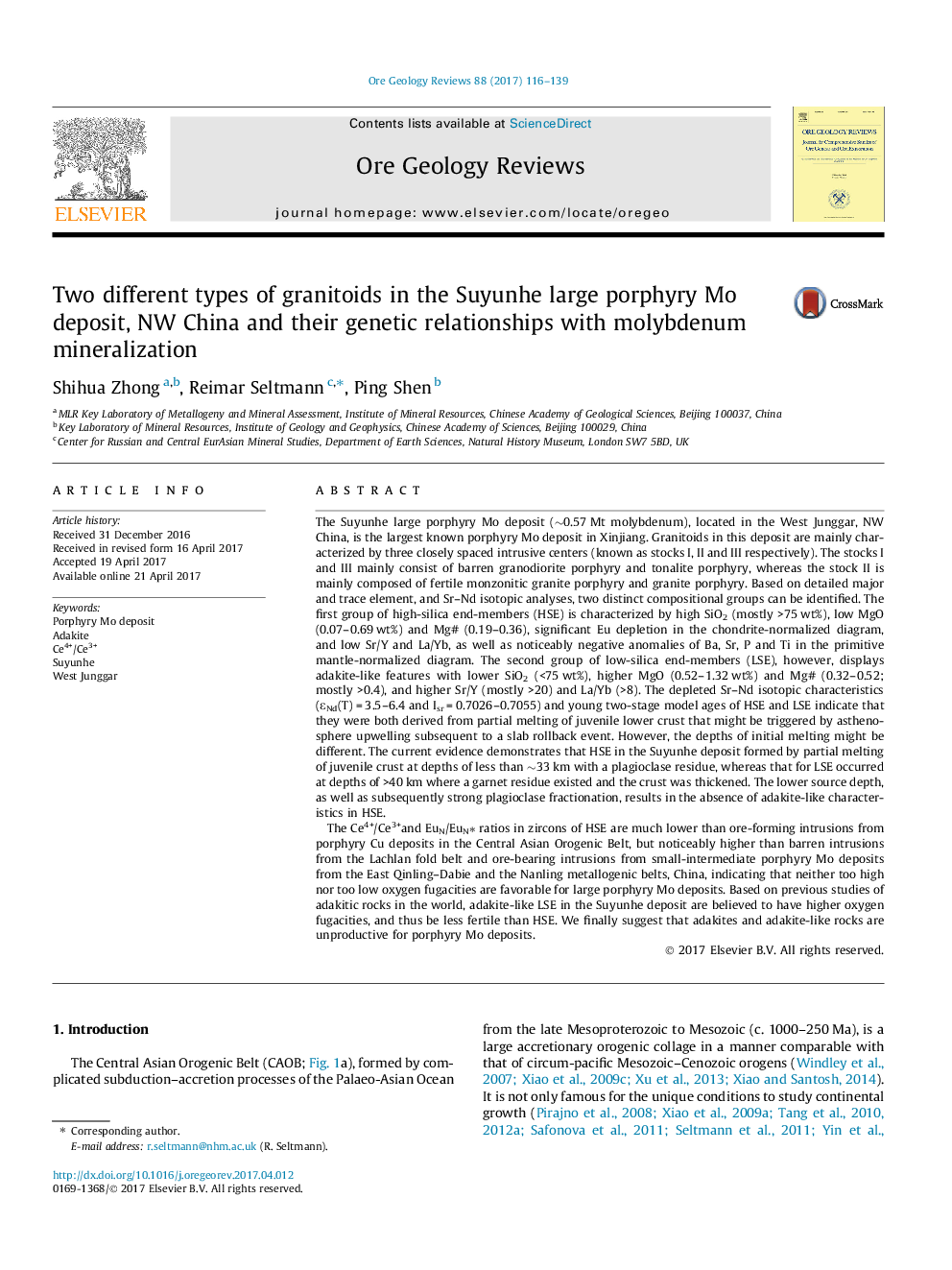| کد مقاله | کد نشریه | سال انتشار | مقاله انگلیسی | نسخه تمام متن |
|---|---|---|---|---|
| 5782323 | 1637219 | 2017 | 24 صفحه PDF | دانلود رایگان |

- Two geochemically contrasting types of granitoids distinguished in West Junggar.
- LSE show adakite-like features.
- LSE originate from source at much deeper crust level than HSE.
- Intermediate fO2 with Ce4+/Ce3+ of 5 to â¼100 indicative of large porphyry Mo deposits.
- Adakitic rocks of West Junggar are unproductive for porphyry Mo deposits.
The Suyunhe large porphyry Mo deposit (â¼0.57 Mt molybdenum), located in the West Junggar, NW China, is the largest known porphyry Mo deposit in Xinjiang. Granitoids in this deposit are mainly characterized by three closely spaced intrusive centers (known as stocks I, II and III respectively). The stocks I and III mainly consist of barren granodiorite porphyry and tonalite porphyry, whereas the stock II is mainly composed of fertile monzonitic granite porphyry and granite porphyry. Based on detailed major and trace element, and Sr-Nd isotopic analyses, two distinct compositional groups can be identified. The first group of high-silica end-members (HSE) is characterized by high SiO2 (mostly >75 wt%), low MgO (0.07-0.69 wt%) and Mg# (0.19-0.36), significant Eu depletion in the chondrite-normalized diagram, and low Sr/Y and La/Yb, as well as noticeably negative anomalies of Ba, Sr, P and Ti in the primitive mantle-normalized diagram. The second group of low-silica end-members (LSE), however, displays adakite-like features with lower SiO2 (<75 wt%), higher MgO (0.52-1.32 wt%) and Mg# (0.32-0.52; mostly >0.4), and higher Sr/Y (mostly >20) and La/Yb (>8). The depleted Sr-Nd isotopic characteristics (εNd(T) = 3.5-6.4 and Isr = 0.7026-0.7055) and young two-stage model ages of HSE and LSE indicate that they were both derived from partial melting of juvenile lower crust that might be triggered by asthenosphere upwelling subsequent to a slab rollback event. However, the depths of initial melting might be different. The current evidence demonstrates that HSE in the Suyunhe deposit formed by partial melting of juvenile crust at depths of less than â¼33 km with a plagioclase residue, whereas that for LSE occurred at depths of >40 km where a garnet residue existed and the crust was thickened. The lower source depth, as well as subsequently strong plagioclase fractionation, results in the absence of adakite-like characteristics in HSE.The Ce4+/Ce3+and EuN/EuNâ ratios in zircons of HSE are much lower than ore-forming intrusions from porphyry Cu deposits in the Central Asian Orogenic Belt, but noticeably higher than barren intrusions from the Lachlan fold belt and ore-bearing intrusions from small-intermediate porphyry Mo deposits from the East Qinling-Dabie and the Nanling metallogenic belts, China, indicating that neither too high nor too low oxygen fugacities are favorable for large porphyry Mo deposits. Based on previous studies of adakitic rocks in the world, adakite-like LSE in the Suyunhe deposit are believed to have higher oxygen fugacities, and thus be less fertile than HSE. We finally suggest that adakites and adakite-like rocks are unproductive for porphyry Mo deposits.
231
Journal: Ore Geology Reviews - Volume 88, August 2017, Pages 116-139